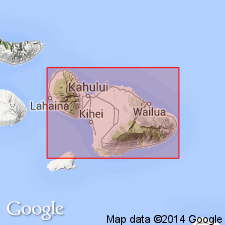
- Usage in publication:
-
- Kula volcanic series*
- Modifications:
-
- Named
- Dominant lithology:
-
- Basalt
- AAPG geologic province:
-
- Maui
Summary:
Named for Kula settlement, west slope of Haleakala [crater] eastern part of Island of Maui. Covers five large areas, largest being on northwest flank of mountain. Composed chiefly of aphanitic dense gray to steel-blue andesitic-type aa flows and thick clinker basalts. Measured section along new Halemauu trail near head of Keanae Valley is 1050 ft thick. Is as much as 2000 ft thick near summit. Overlies with gradational contact Honomanu volcanic series (new). Underlies with erosional unconformity Hana volcanic series (new). Stratigraphic section shows early and middle Pleistocene age but map shows probably Pliocene and early and middle Pleistocene age.
Source: GNU records (USGS DDS-6; Menlo GNULEX).
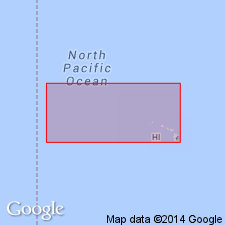
- Usage in publication:
-
- Kula volcanic series*
- Modifications:
-
- Age modified
- AAPG geologic province:
-
- Maui
Summary:
Age of Kula volcanic series changed to Pliocene and Pleistocene(?).
Source: GNU records (USGS DDS-6; Menlo GNULEX).
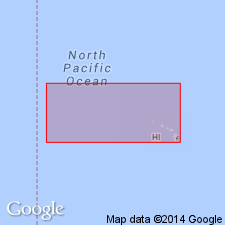
- Usage in publication:
-
- Kula volcanic series*
- Modifications:
-
- Age modified
- AAPG geologic province:
-
- Maui
Summary:
Type locality: Kula [now called Waiakoa] district [20 deg 45' 45"N, 156 deg 19' 48"W, Kilohana 7.5' quad] east part of Island of Maui, HI. Believed to be correlative with Honolua volcanic series on west Maui and probably at least in part with Pololu volcanic series on Kohala Mountain on Island of Hawaii. Assigned late Tertiary(?) age.
Source: GNU records (USGS DDS-6; Menlo GNULEX).
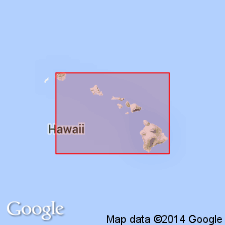
- Usage in publication:
-
- Kula volcanic series*
- Modifications:
-
- Geochronologic dating
- AAPG geologic province:
-
- Maui
Summary:
K-Ar ages (on hawaiite of Kula volcanic series collected on N and E coast of E Maui) range from 0.86 to 0.46 Ma.
Source: GNU records (USGS DDS-6; Menlo GNULEX).
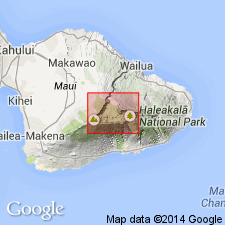
- Usage in publication:
-
- Kula Formation*
- Modifications:
-
- Revised
- Areal extent
- AAPG geologic province:
-
- Maui
Summary:
Kula Volcanic Series of Stearns and Macdonald (1942) reduced in rank and renamed Kula Formation in accordance with Code. In W wall of Haleakala crater, lavas previously mapped as Honomanu (Stearns and Macdonald, 1942, pl.1) are shown as part of Kula Formation on this map. In addition to predominant hawaiite, unit contains alkali olivine basalt, and picrite basalt with phenocrysts of olivine and augite. Is Pleistocene age based on K-Ar determinations (McDougall, 1964).
Source: GNU records (USGS DDS-6; Menlo GNULEX).
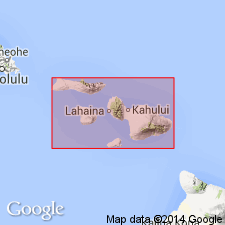
- Usage in publication:
-
- Kula Volcanic Series*
- Modifications:
-
- Geochronologic dating
- AAPG geologic province:
-
- Maui
Summary:
K-Ar ages (on trachytic dike rock and hawaiite from rim of Haleakala Crater and roadcut off Haleakala Hwy toward Kailua Gulch) ranged from 0.56 +/-0.14 to 0.36 +/-0.07 Ma
Source: GNU records (USGS DDS-6; Menlo GNULEX).

- Usage in publication:
-
- Kula Volcanics*
- Modifications:
-
- Revised
- Reference
- Redescribed
- AAPG geologic province:
-
- Maui
Summary:
Kula Formation (Macdonald, 1978) and Kumuiliahi Formation (Macdonald, 1978), formerly considered by Stearns and Macdonald (1942) to be part of Honomanu Volcanic Series, are here renamed Kula Volcanics to reflect varied lithology. Type locality is along Hwy 37 near Waiakoa (Kula Post Office) about 7 km NE of Kula Hospital. Reference localities are along Kaupo-Kipahulu road near Kipahulu and along Halemauu Trail in Haleakala Crater area.
Source: GNU records (USGS DDS-6; Menlo GNULEX).
For more information, please contact Nancy Stamm, Geologic Names Committee Secretary.
Asterisk (*) indicates published by U.S. Geological Survey authors.
"No current usage" (†) implies that a name has been abandoned or has fallen into disuse. Former usage and, if known, replacement name given in parentheses ( ).
Slash (/) indicates name conflicts with nomenclatural guidelines (CSN, 1933; ACSN, 1961, 1970; NACSN, 1983, 2005, 2021). May be explained within brackets ([ ]).

